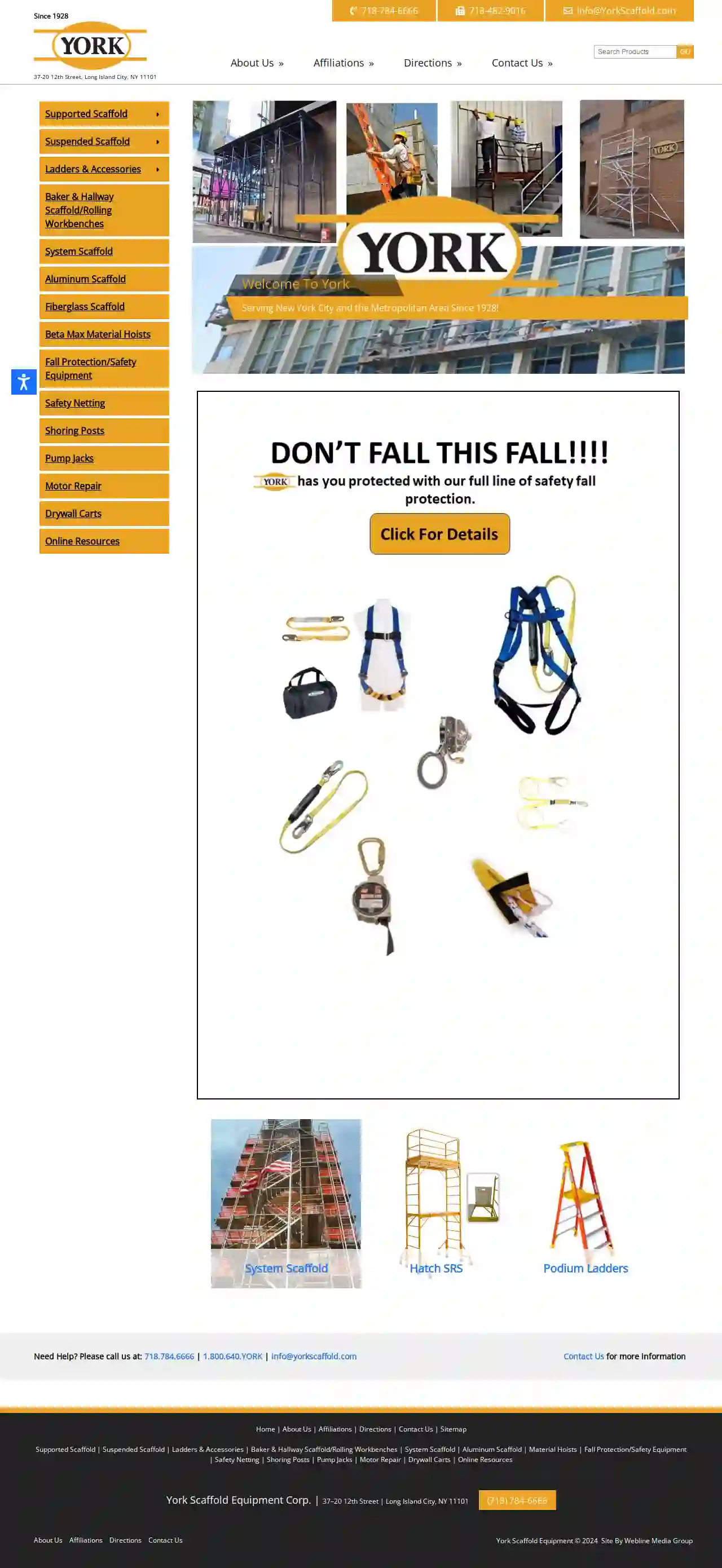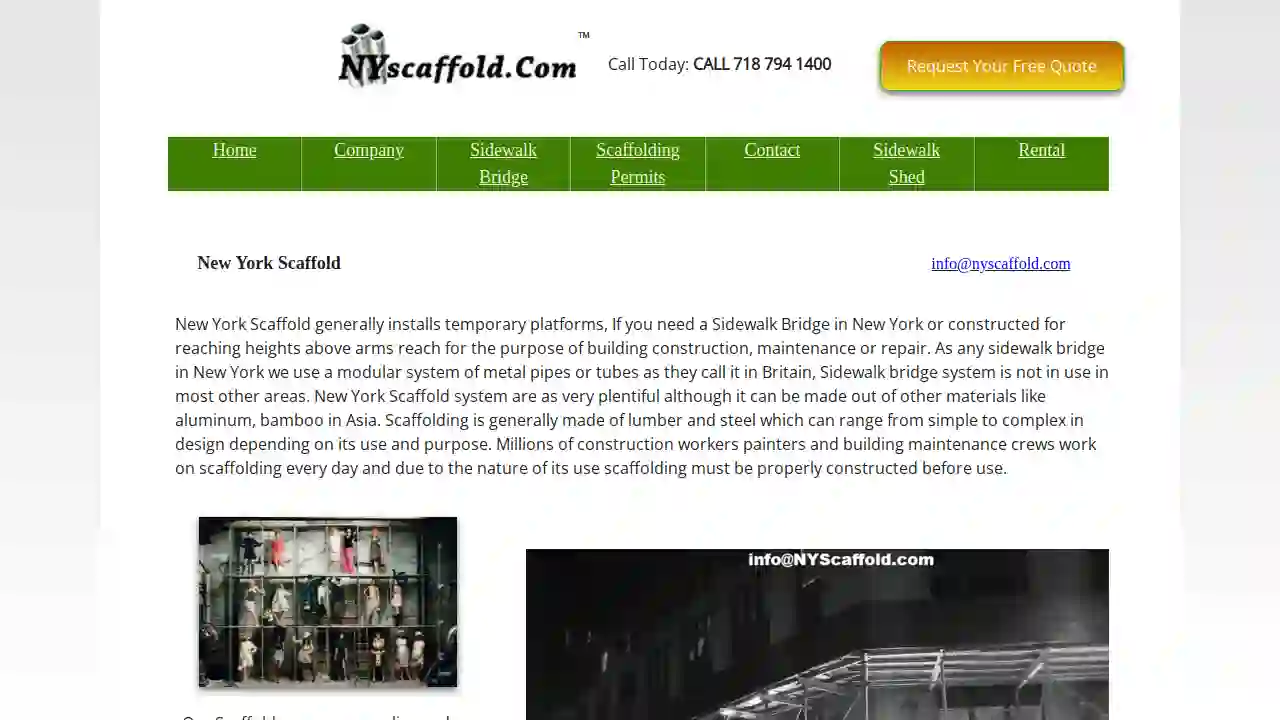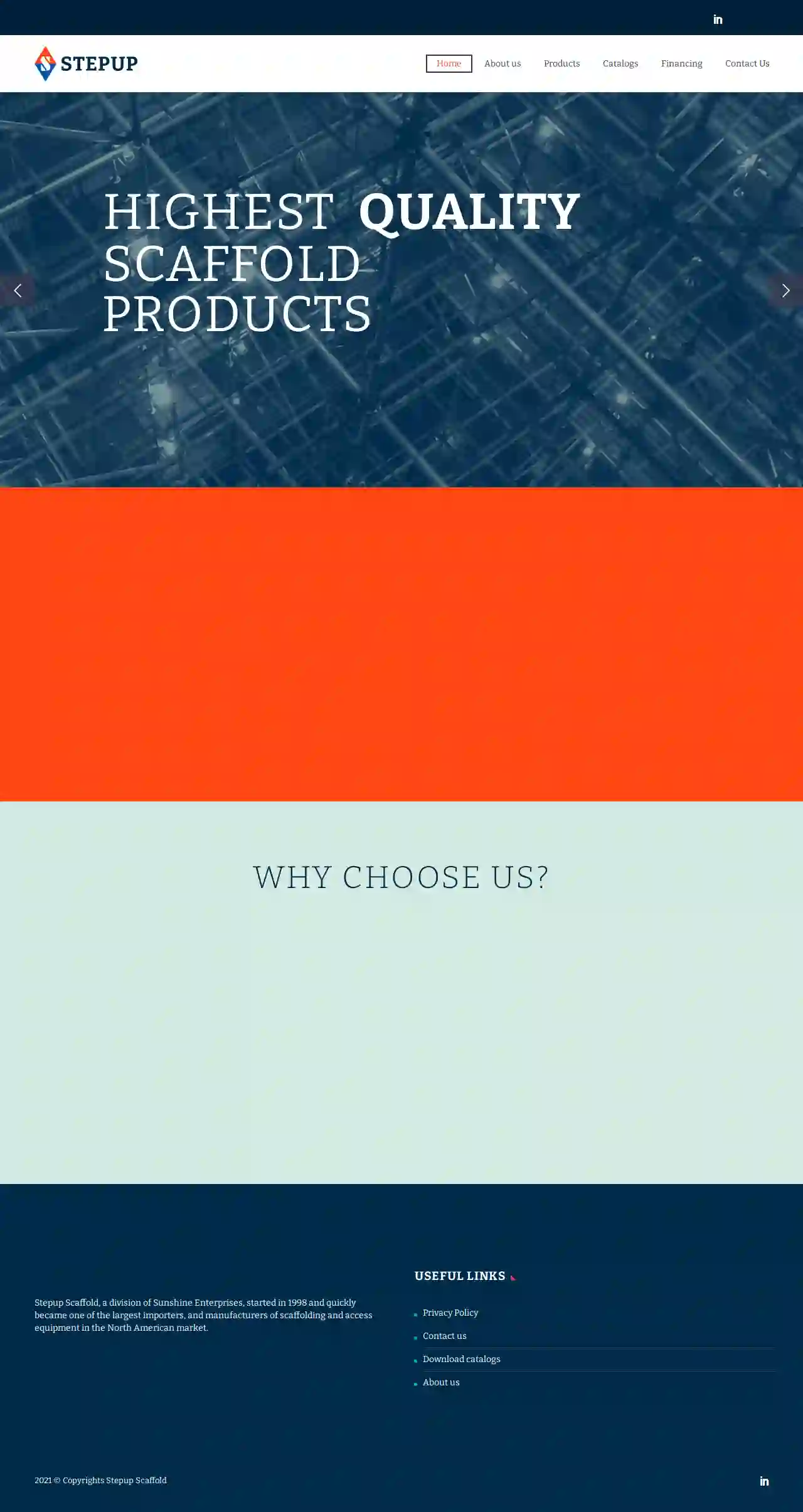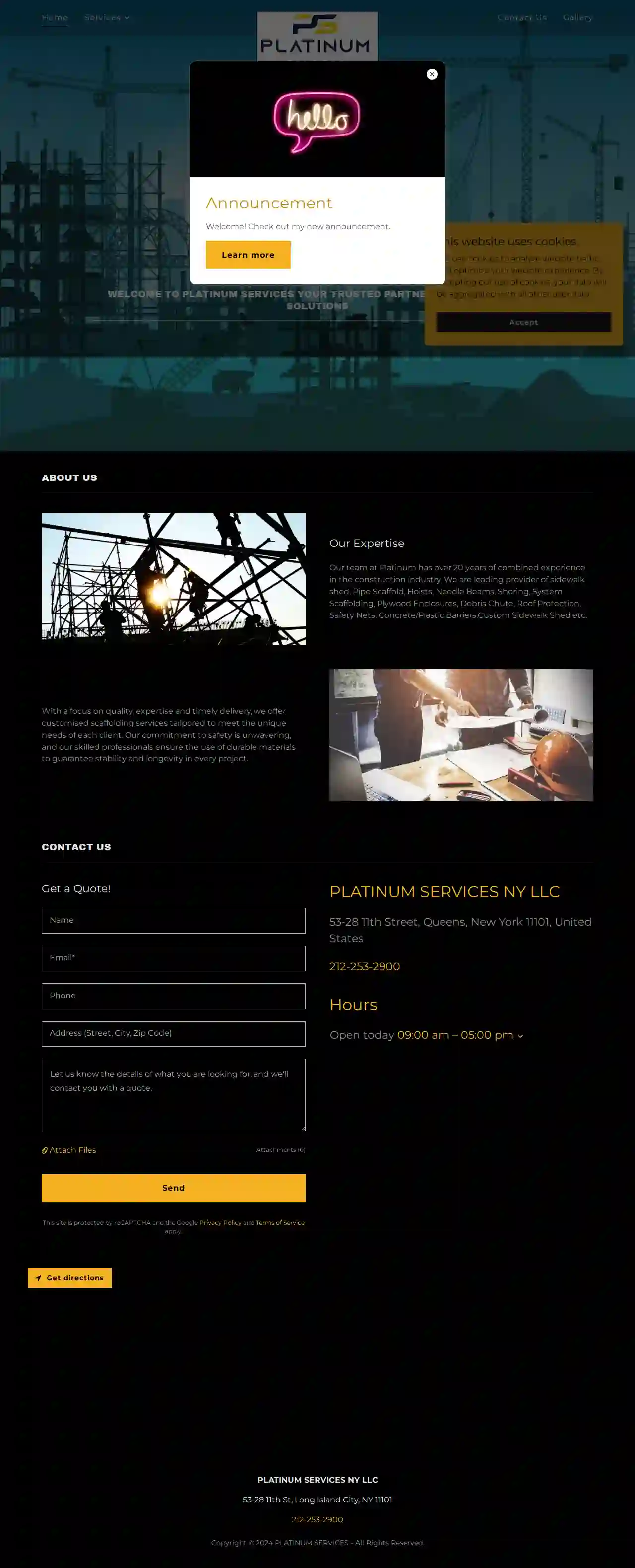Scaffolding Companies Jefferson Hills
Find Scaffolding Erectors in Jefferson Hills
Receive 3 FREE Scaffolding Company quotes for your project today! Compare profiles, reviews, accreditations, portfolio, etc... and choose the best deal.

York Equipment Corp.
4.628 reviewsLong Island City, NY, 37-20 12th Street, 11101, USYork Scaffold Equipment Corp. has been serving New York City and the Metropolitan Area since 1928. The company specializes in providing a wide range of scaffolding solutions, including supported, suspended, and system scaffolds, as well as ladders, accessories, and safety equipment. With a strong commitment to customer satisfaction and safety, York Scaffold Equipment Corp. offers top-quality products and services to meet the needs of construction and renovation projects.
- Services
- Why Us?
- Accreditations
- Our Team
- Testimonials
- Gallery
Get Quote
Celtic Scaffolding Company
4.214 reviewsYork, USAt Celtic Scaffold, we specialize in providing top-notch scaffolding services to our clients in New York City. With years of experience in the industry, our team of experts is well-versed in the different types of scaffolds, including pipe scaffolds and hanging or suspension scaffolds. Our pipe scaffolds are stationary and constructed with pipes, erected from the ground up along the side of a building. We ensure that our pipe scaffolds comply with the regulations set by the Construction Division within each borough office of the Department of Buildings (DOB). On the other hand, our hanging or suspension scaffolds are supported from the roof or setback of a building and held by either cables or rope. We contract master riggers or special riggers for the work, and each worker using or operating the suspension scaffold must be employed by the master rigger, special rigger, or their company.
- Services
- Why Us?
- Gallery
Get Quote
West New York Restoration of CT, INC
4.512 reviews1800 Boston Rd, Bronx, 10460, USWest New York Restoration of CT, Inc was founded in 1984 by Principal Alfred Gallicchio with the goal of providing high-quality contracting services in the field of exterior restoration, roofing and waterproofing. The philosophy of the company and its owner is a simple and direct one: to combine experience, management services, and skilled workforce to achieve the highest level of quality for each project. West New York Restoration of CT, Inc.'s key personnel bring a wealth of experience to each project. Whether the problem at hand concerns roofing, waterproofing, masonry, or structural repair, West New York Restoration of CT, Inc. can provide the solution.
- Services
- Why Us?
- Our Team
- Gallery
Get Quote
Dynamic Hoisting & Scaffolding
54 reviews43-30 48th St, Long Island City, 11104, USAt Dynamic Hoisting & Scaffolding, we transform your vision into reality with our expertise in hoisting and scaffolding solutions. Our team is dedicated to delivering exceptional results, ensuring your projects are completed on time and within budget. Established in 2013, Dynamic Hoisting & Scaffolding is dedicated to providing high-quality construction services that exceed our clients' expectations. Our mission is to innovate, sustain, and continually improve every aspect of our work. Join us in transforming the construction landscape with our reliable scaffolding solutions. We use the highest quality materials and craftsmanship to ensure durability and excellence in every project. We conduct our business with transparency, honesty, and respect, prioritize the safety of our employees, clients, and the community, and embrace new technologies and methods to enhance efficiency and effectiveness.
- Services
- Why Us?
- Testimonials
- Gallery
Get Quote
NY Scaffold
51 reviewsYork, USWe are national scaffold contractors and scaffolding erectors. Experienced NY Scaffold erectors can provide a range of access services for you or your clients, we also take care of any and all NYC DOB Permits. Large and small projects; industrial, commercial and domestic sectors can hire the services of NY Scaffold erectors. No job is too big or too small for us and we have grown our business in the last few years to become one of the leading erectors of scaffolding and sidewalk bridges in the NYC area. Plan your project with complete confidence the sidewalk bridge company NYC can erect scaffolding to all types of structures. NYC installs scaffolds from access towers to bridges and any other type of access equipment that your firm might require. It does not matter how big or how small your project is NY scaffold company NYC will cater to your needs. They have secure access equipment that is perfect for projects in and around the region. Our Scaffolding has several unique safety features that benefit the system’s erectors, users and project inspectors. With eight completely variable component node points and the largest available bay sizes, Our Scaffolding offers the most flexible system. Only five main components are required for basic use and the only erection tools required are a hammer and level. The system’s optimum design offers a high load rating and extreme rigidity, keeping your workers secure and productive. NY Scaffold is the leading specialty Scaffold Erector Company covering the whole of the US. We are totally focused on customer satisfaction and pride ourselves on the range of services we provide, We have 95% repeat business on an ongoing basis. NY Scaffold is fully self-sufficient and one the largest stockholders of the sidewalk bridge system within the US. This forms the basis of the NY Scaffolds motto safety speed efficiency. Our business is based around the materials that are stored in bins and are loaded by forklift in our yards and unloaded on site by our Truck mounted Booms. We deliver our scaffolding equipment to your site, and our team of experienced erectors will set it up for you, ensuring that your project is completed safely and efficiently.
- Services
- Why Us?
- Gallery
Get Quote
StepUp Scaffolding Warehouse - NY Branch
4.426 reviews1234 NW 12th St, Miami, 33122, USStepup Scaffold, a division of Sunshine Enterprises, started in 1998 and quickly became one of the largest importers and manufacturers of scaffolding and access equipment in the North American market. Our commitment to Quality, Service, and Satisfaction influences everything we do. We believe that a high tide raises all boats, so to raise everything and everyone, our statement of purpose, simply put is that “We elevate our employees, customers, and industries to safely move, build, and maintain the world.”
- Services
- Why Us?
- Accreditations
- Our Team
- Testimonials
- Gallery
Get Quote
Platinum Services
34 reviews53-28 11th St, Long Island City, 11101, USWelcome to Platinum Services, your trusted partner in scaffolding solutions. With over 20 years of combined experience in the construction industry, our team at Platinum has the expertise to provide customized scaffolding services tailored to meet the unique needs of each client. Our commitment to safety is unwavering, and our skilled professionals ensure the use of durable materials to guarantee stability and longevity in every project. We offer a range of services, including sidewalk shed, Pipe Scaffold, Hoists, Needle Beams, Shoring, System Scaffolding, Plywood Enclosures, Debris Chute, Roof Protection, Safety Nets, Concrete/Plastic Barriers, and Custom Sidewalk Shed. Contact us today to get a quote and learn more about our services.
- Services
- Why Us?
- Gallery
Get Quote
MG Rigging & Scaffolding Services
51 reviews48-11 69th Street, Woodside, 11377, USMG Rigging and Scaffolding Services is a one-stop shop for Suspended Access needs in NYC, NY, Long Island, and New Jersey. With hands-on rigging experience and extensive knowledge of products and regulations governing the scaffolding industry, our staff provides top-notch services. From Suspended Scaffolding Rental, Installation, and Sales to Special Rigger Services and Rigging Safety consulting, we've got you covered. Our team assists Engineers and Architects with Local Law 11 Facade Inspections and Repairs, and we offer Engineered Plans, CD5 Permits, DOL Permits, and Expediting. We're committed to providing exceptional service and ensuring your project is completed safely and efficiently.
- Services
- Why Us?
- Accreditations
- Gallery
Get Quote
NYC Sidewalk Shed & Pipe Scaffolding
51 reviews1078 Arnow Ave, Bronx, NY, USAbout NYC Sidewalk Shed & Pipe Scaffolding NYC Sidewalk Shed & Pipe Scaffolding is the most trusted provider of premium quality sidewalk sheds and pipe scaffolding in NYC. We are the leading pipe scaffolding and sidewalk erector company, providing services in the whole of NYC. As a result of 20+ years of experience in the industry, we have become adept in providing high-quality sidewalk sheds and pipe scaffoldings consistently earning the satisfaction of all our clients. Our Mission At NYC, our mission is to provide excellent sidewalk shed and scaffolding services at extremely affordable rates. Hence, providing quality and safety that’s within everyone’s’ reach. From modern equipment to the best professionals, we try to cater to you with the best in every aspect. We aim to completely redefine what is possible in the construction industry by setting new standards for safety, efficiency, and innovation. Why Choose Us Providing you with high-quality solutions for all your problems is our foremost concern. We work with skilled professionals that have years of experience in dealing with sidewalk sheds and pipe scaffoldings. Besides, we make sure to use the best quality material sourced from the best manufactures. Hence, ensuring you quality structures that can withstand the test of time. Duralbes and Safe Structures We design safe and reliable pipe scaffoldings and sidewalk structures that can easily support the desired load. These structures will be stable and robust ensuring safety for everyone. Moreover, we assure compliance with both local and international safety codes, ensuring the complete safety of pedestrians and site workers from all sorts of accidents.
- Services
- Why Us?
- Gallery
Get Quote
LMB Industrial Services, Inc.
52 reviewsP.O. Box 606, Birdsboro, 19508, USLMB Industrial Services, Inc. is a one-stop shop for reliable, affordable, on-time refractory, scaffolding, robotic demolition, and mechanical services. Founded in 2007, the company's vision is to be the best refractory engineering company/contractor in the US. With a 97% customer retention rate, LMB focuses on five key pillars of success: safety, on-time delivery, quality, price, and experience. The company's team members are trained to uphold the same values and standards as project managers, ensuring superior quality in every project. LMB provides fair and honest assessments of projects, avoiding lowballing upfront costs and backloading with extras. The company's administrative office and warehouse are located in Birdsboro and Pottsville, PA, respectively.
- Services
- Why Us?
- Accreditations
- Gallery
Get Quote
Over 2,353+ Scaffolding Businesses registered
Our scaffolding experts operate in Jefferson Hills and surroundings!
ScaffoldingHQ has curated and vetted the Best Scaffolding Businesses near Jefferson Hills. Find a reliable contractor today.
Frequently Asked Questions About Scaffolding Companies
- A larger, more complex structure typically used for accessing multiple levels of a building.
- Offers greater height and versatility.
- Often used for construction, renovation, and maintenance.
- Smaller, portable platforms usually used for tasks at a single level.
- Commonly used for painting, plastering, or light repairs.
- Can be rolling or stationary.
- Experience: 'How long have you been in business, and what experience do you have with projects like mine?'
- Licensing and Insurance: 'Are you fully licensed and insured, and can I see proof of coverage?'
- Safety Record: 'What are your safety procedures, and how do you ensure worker safety on the job site?'
- References: 'Can you provide references from previous clients?'
- Quotes and Costs: 'Can you provide a detailed quote that outlines all costs, including materials, labor, and any additional services?'
- Project Timeline: 'What is the estimated timeframe for scaffolding erection and dismantling?'
- Communication: 'How will you communicate with me throughout the project?'
- Size and Complexity: Larger, more intricate scaffolding structures will naturally take longer to assemble.
- Scaffolding Type: System scaffolding, with its pre-engineered components, can be erected faster than traditional tube and clamp scaffolding.
- Accessibility: Difficult site access or limited working space can prolong the erection process.
- Crew Size and Experience: The number and skill level of the scaffolding erectors will impact the speed of assembly.
What is the difference between scaffolding and staging?
Scaffolding:
What questions should I ask a scaffolding company before hiring them?
Can I erect scaffolding myself?
How long does it take to erect scaffolding?
What is the difference between scaffolding and staging?
Scaffolding:
- A larger, more complex structure typically used for accessing multiple levels of a building.
- Offers greater height and versatility.
- Often used for construction, renovation, and maintenance.
- Smaller, portable platforms usually used for tasks at a single level.
- Commonly used for painting, plastering, or light repairs.
- Can be rolling or stationary.
What questions should I ask a scaffolding company before hiring them?
- Experience: 'How long have you been in business, and what experience do you have with projects like mine?'
- Licensing and Insurance: 'Are you fully licensed and insured, and can I see proof of coverage?'
- Safety Record: 'What are your safety procedures, and how do you ensure worker safety on the job site?'
- References: 'Can you provide references from previous clients?'
- Quotes and Costs: 'Can you provide a detailed quote that outlines all costs, including materials, labor, and any additional services?'
- Project Timeline: 'What is the estimated timeframe for scaffolding erection and dismantling?'
- Communication: 'How will you communicate with me throughout the project?'
Can I erect scaffolding myself?
How long does it take to erect scaffolding?
- Size and Complexity: Larger, more intricate scaffolding structures will naturally take longer to assemble.
- Scaffolding Type: System scaffolding, with its pre-engineered components, can be erected faster than traditional tube and clamp scaffolding.
- Accessibility: Difficult site access or limited working space can prolong the erection process.
- Crew Size and Experience: The number and skill level of the scaffolding erectors will impact the speed of assembly.